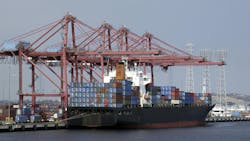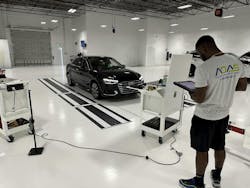War, Strikes, and Upgrades: The 2024 Outlook for Collision Repair
Last year brought notable increases in costs. From gasoline to health insurance, wallets seemed to be feeling lighter and lighter.
Now, rising costs to ship products will be borne by consumers. The UAW strike and the ongoing conflict in the Middle East will likely have long-term effects on the collision repair industry in the second half of 2024.
From Gaza to Your Garage
In response to Israel’s actions in the Palestinian territories of Gaza and the West Bank after the attack on October 7, 2023, the Houthi Yemeni forces began hijacking commercial ships moving through the Red Sea in November. Commercial shipping in that region makes up 12 percent of all commercial shipping.
"It seems disconnected from us here in North America, but right now 12% of global cargo moves through the Red Sea," said Ryan Mandell, director of claims performance for Mitchell International, Inc., during a CIECA Webinar in January. He explained that companies are removing that region from their global logistics strategy.
"When you take 12% capacity offline, that is going to have a domino effect when you look at the overall supply chain health." Some companies continue to use that route, with naval escorts, but still get attacked, according to Mandell. During the webinar, he mentioned that the Global Container Freight Index, which measures the cost of moving one shipping container anywhere in the world, has jumped 18.37% since the conflict in the Red Sea began.
Previously, the average cost to move a shipping container ranged from $1,200 to $1,400. As of January, that number is around $3,000.
The potential result of these costs, according to Mandell’s presentation, could be companies passing along the full cost to consumers and changes in what products get shipped.
After a U.S.-led coalition began airstrikes across Yemen, signs of the conflict cooling down, along with normal passage through the Red Sea, seemed more distant than ever. Mandell told FenderBender that the cost effects on shipping because of this conflict could linger within the industry throughout the year, or even longer.
"It’s hard to quantify just what that would look like."
UAW Strikes are Done But Not Over
2023 was a year for strikes, for workers in companies like Amazon and Starbucks, as well as the Writer’s Guild of America and the Screen Actors Guild. The strike that did not receive as much attention was the United Auto Workers’ strike, which lasted from September 15, 2023, to October 30, 2023.
The UAW sought 40-percent wage increases, cost of living increases, a 32-hour workweek, more vacation days, a cap on the number of temporary workers, better retirement benefits, and a return of the jobs bank that guaranteed workers they would be paid most of their wages even if work wasn’t available. After 46 days, the UAW announced a tentative contract with Ford Motor Co., which called for pay increases of 25 percent, among other major concessions.
"Everything involved greater costs," Mandell said about the concessions made at the end of the strike. "It all comes down to the OEMs’ bottom line. They have to recover those costs somehow. Typically, that means those costs are going to be passed down to the consumer. On the collision side, the parts aspect is where we’re going to see it first."
"There’s a bit of a trickle-down effect," he said in a phone interview with FenderBender.
"When you look at those tier-one parts suppliers, and they’re not manufacturing parts for their OEM partners, they have to decide if they’re going to keep their employees paid or are they going to put them on furlough while they’re waiting for the strike to resolve."
From what he has seen, most tier-one suppliers decided to keep their workers employed during that time. However, he does wonder if this could cause additional cost pressure throughout the year for parts, although he said it’s too early to tell.
Although the strike lasted less than two months, its effects are still being felt. FenderBender reported that body shops in East Texas are busy after hailstorms swept through the region in early February, according to local outlets, but parts shortages are delaying some delivery times.
David Harkey, the owner of H&S Paint and Body Shop in Kilgore, Texas, told FenderBender that a representative from GM explained the delay in parts is due to the UAW strikes. He said H&S is expecting a three-week timeline to deliver a car that needs no replacement parts and a longer wait for those that do.
Vehicles are Changing
No matter how the parts arrive or who is manufacturing them, one thing is certain: vehicles are becoming increasingly complex, especially with Advanced Driver Assistance Systems (ADAS).
“I believe many more manufacturers are adopting a policy that ‘Anytime a vehicle is involved in an accident, certain systems will need to be calibrated.’ This will increase the frequency of those calibrations,” Mandell continued.
“More broadly, I think we will see increased adoption of Electric Vehicles (EVs), perhaps not at the breakneck pace that many expected. There is still some negative consumer sentiment around these vehicles.”
A study published this year by DriveElectric states that the share of car sales for EVs in the U.S. is just under eight percent. Although this is dwarfed by other countries like Norway (88 percent) in the same metric, the U.S. still has enough market share for collision repairers, in Mandell’s opinion, to prepare to take on more EVs this year, even in markets where EVs are still scarce.
In fact, a collision technician survey by I-CAR and SCRS, in collaboration with Ducker Carlisle, shows that 90 percent of survey participants in late 2023 have had an EV or a car with ADAS in their shop.
The complexity of today’s vehicles compared to those of the past contributes to the rising cost of collision repair. When asked if the costs will eventually flatten out as car technology advances, Mandell said, “Gosh! I hope so!”
“At some point, yes, but I don’t think it’s imminent.”
As the average model year of vehicles gets newer, so does the number of ADAS calibrations that shops need to handle.
“Shops need to have a very intentional strategy around this (ADAS). Not only from a profit margin perspective, like what’s going to make more profit for me, but also from a cycle time perspective.”
Cars may be improving in many ways, but collision repairers might have something else to say about the training they receive to handle the job. The same survey also revealed that fewer than half of the nearly 840 technicians are at least somewhat satisfied with their training.
Mandell asks collision shop owners to consider: “How am I going to handle this ADAS calibration? Am I going to sublet this to a third party? If so, how do I do that as efficiently as possible, and guarantee the highest quality of work possible? Or is this something I am going to invest in for tools, training, and equipment to do the work in-house?”
About the Author
Abdulla Gaafarelkhalifa
Abdulla Gaafarelkhalifa is a former associate editor at FenderBender and ABRN. He has a bachelor’s degree in English from the University of Wisconsin-La Crosse and has covered various beats beyond collision repair news such as politics, education, sports, and religion. His first car was a silver 2009 Chrysler Sebring, which he nicknamed the Enterprise because he’s a Star Trek fan. He now drives a 2014 Jeep Cherokee in order to tolerate Minnesota winters.




